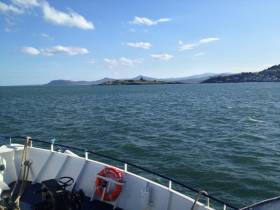Displaying items by tag: UNESCO Biosphere
#dublinbay - As part of the Bullock Harbour Bicentenary lecture series to mark and celebrate the construction of the small scenic south Dublin Bay harbour in Dalkey, a panel discussion will focus on the Bay itself.
The Bullock Harbour Preservation Association (BHPA) in conjunction with the Dublin Port Company have been organising the series which began in November last year.
Likewise of previous lectures this penulitmate event will be held in the Dalkey Castle & Heritage Centre on Tuesday, 9 April at 8pm. All are welcome to the Panel Discussion which is free and there is no need to book in advance.
The panel discussion will focus on the environment of the bay, present and future, covering biodiversity and the conservation of the marine and bird life.
Speakers include:
Ann Murray, DLRCC Biodiversity Officer and Dublin Bay Biosphere Partnership
Richard Nairn, Ecologist and author of 'Dublin Bay: Nature and History'
Hannah Keogh, Irish Whale & Dolphin Group
Professor John Brannigan, UCD, on Cultural Aspects of Coastal Environments
For further information in general about the harbour visit the BHPA website here.
#BiosphereTours – Dublin Bay Biosphere Guided Tours begin today from Dun Laoghaire Harbour, Dublin and Howth and on every Wednesday until 14 June, writes Jehan Ashmore.
Dublin Bay which is internationally recognised for its wealth of marine wildlife and cultural heritage was in 2015 awarded a “UNESCO Biosphere”. The designation status from United Nations Educational, Scientific and Cultural Organisation was in recognition to unique places such as Dublin Bay. The biosphere is actively managed to promote a balanced relationship between people and nature. To find out much more, to get involved and events click here.
Dun Laoghaire-Rathdown County Council as part of the Dublin Bay Biosphere Partnership, encourage you to take this opportunity in appreciating our beautiful bay from a truly unique perspective.
In addition to marine wildlife (including ceteceans) there are stunning landscapes views of the Dublin Mountains and to the south in the bay is Dalkey Island. While off Howth Peninula with its cliffs, lies Ireland’s Eye and further offshore Lambay Island. In the far distance are also the Mountains of Mourne.
Manmade landmarks can also be observed, among them Joyce’s Martello Tower, Sandycove, the Poolbeg Lighthouse that marks the entrance to Dublin Port and the capital. On the bay's north side approaches to the port is another iconic coastal landmark the Baily Lighthouse.
Operating the Biosphere Tours in conjunction with Dublin Bay Cruises is the excursion vessel, St Bridget. The (pre-booked) tours up to Wednesday 14 June will run between 60-90 minutes duration depending on which route is taken.
Embarkation locations: Dun Laoghaire Harbour (East Pier), Dublin on the Liffey (Sir John Rogerson’s Quay) and in Howth Harbour (West Pier).
For more information on tours and cruise routes, times, charges and booking information, click here.























